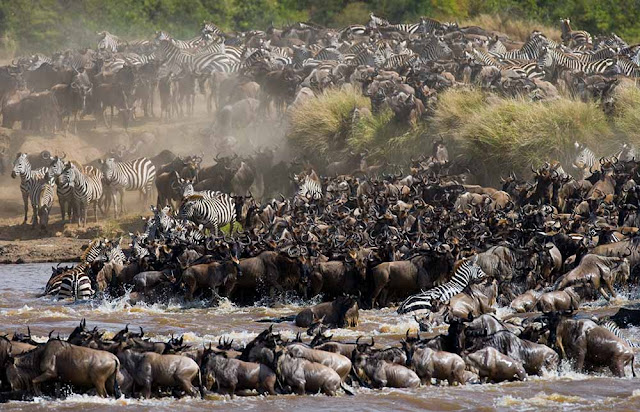WHEN SHOULD I COME FOR MIGRATION SAFARI
PEAK CLIMBERS ADVENTURES WE SUGGEST !You don't need to stress over having confused calendar. If you need to go for Tanzania safari to observe the Wildebeest Migration, even a couple of week outing is sufficient to leave you dazed.
Migration happens throughout the entire year. Millions and thousands of wildebeests, zebras, Thompson's gazelles, elands, and impalas traverse the immense fields of Serengeti in the quest for better grazing.
Below are the calendar for migration for the entire year from January to December.
January
Wildebeest begin to gather in the southern plains, from Moru south to Naabi, Kusini and Ndutu. The short grasses here are rich in phosphorus and magnesium due to the volcanic ash of the calcrete layer just below the plains’ shallow soil. Pack your waterproof items, as there may be intense thunderstorms throughout the region. You may be rewarded with a few early calving sightings.
February
February is peak calving month, and there’s nothing quite like the sight of hundreds of thousands of newborn wildebeest taking their first steps amid stationary herds. You can spot them from the Ndutu and Kusini plains, all the way toward the Ngorongoro Highlands. This is the driest month of the rainy season, although sparse showers still occur.
March
Toward the end of the calving season, the herds are mostly still stationary in the Ndutu-Kusini area, with some animals permeating even further south into Maswa and east in the direction of Namiri Plains (prime predator country, so keep your camera close). The last of the wildebeest calves are born amid heavy, regional thunderstorms.
April
This is the last month you’ll be able to witness the massive herds (plus calves) taking it slow on the plains in the Naabi and Kusini areas. They’ll be making the most of what remains of the nutritious Digitaria, Sporobolus, Andropogon and Cynodon grasses before beginning their long and often perilous journey north.
May
Starting this month, the wildebeest will continually be on the move, heading north through the Moru Kopjes and toward the Western Corridor. Dramatic thunderstorms (good to photograph) persist, providing water to the medium-to-tall Pennisetum and Tussocky Themeda grasses that the herds will now be grazing on. There is slightly less nutrition in the vegetation, prompting the animals’ continued movement northward.
June
The Great Migration is in full swing, travelling swiftly up through the Western Corridor and Grumeti Reserve. It’s peak rutting time, as well as the beginning of the dry season, though there are still localised showers in the north. From now on, the animals’ nutrition depends largely on the growth stage of the Digitaria, Pennisetum, Eustachys and Themeda grasses anchored in nutrient-rich clay amid the woodlands.
July
For wildebeest, the grass really is greener on the other side — of the Mara and Sand rivers, that is. Crossings are the stuff nature documentaries are made of, and a stay at Sayari means you’re perfectly positioned to catch the action. The head of the herd will have reached the Kogatende area in the northern Serengeti, ready to cross the Mara and Sand rivers, complete with hungry crocodiles lurking in the water.
August
For the most part, herds will cross south to north, drawn by the more nutritious grazing on the northern side thanks to earlier showers. However, some crossings also occur in the opposite direction. For spectacular sightings of the bulk of the wildebeest herds, interspersed with dazzles of zebra and herds of antelope, head to the Lamai Wedge and Nyamalumbwa Plains.
September
River traffic flows in both directions between Kenya and Tanzania in September, though a southerly direction will prevail by the end of the month. This treacherous traverse is one of nature’s greatest and most tragic spectacles, and tens of thousands of animals will die in the attempt. The rains remain absent in the south, with sparse showers still occurring in the north.
October
The tail end of the herd crosses the river from Kenya down into Tanzania, as thunderstorms begin in the north. Meanwhile, the bulk of the animals are moving back down into the Lobo Valley region and Grumeti Reserve, tracing their epic annual circle back south toward their calving grounds.
November
Marching ever onward, the herds have largely left the north and are passing through the Lobo region toward the central Serengeti. Rain is still scarce here, and the nutrition inherent in the grasslands is less than ideal. Interestingly, the reason the wildebeest can still share grazing land with zebra is because the two animals consume different parts of individual blades of grass.
December
The Great Migration is now dispersed across the central Serengeti, from as far north as Lobo, to the southern reaches of Ndutu. The rains catch up at last with the still-moving herds, and intense thunderstorms and localised showers are experienced across the region. The animals have returned to the more nutritious
YOU CAN BOOK OUR TANZANIA EXPEDITION BELOW.











Comments
Post a Comment